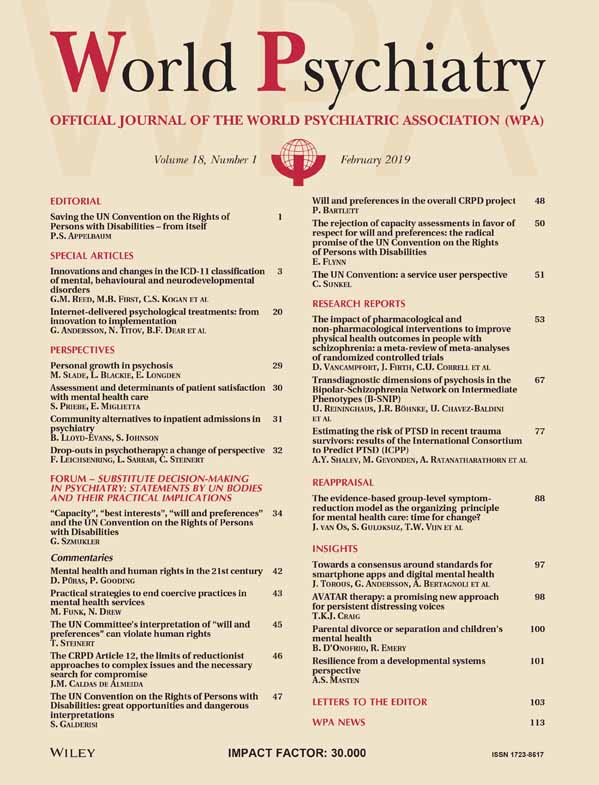ICD-11 sessions within the 18th World Congress of Psychiatry
Within the 18th World Congress of Psychiatry, held in Mexico City from 27 to 30 September 2018, one presidential symposium, one course and several individual presentations focused on various aspects of the chapter on mental and behavioural disorders of the 11th edition of the International Classification of Diseases and Health Problems (ICD-11).
The statistical version of the chapter, containing the hierarchical structure, the category names, the code numbers, brief definitions of each disorder, and inclusion and exclusion terms, was released to the World Health Organization (WHO) Mem-ber States in June 2018 to prepare for implementation. This version is available online at https://icd.who.int/dev11/l-m/en.
The ICD-11 is scheduled for approval by the World Health Assembly in May 2019. The Clinical Descriptions and Diagnostic Guidelines, intended for use by health professionals in clinical settings, will be published as soon as possible after that.
A primary care version of the chapter is also being developed, whereas a research version may be developed later.
The field testing of the chapter has been now completed. It is important to emphasize that it was conducted before the finalization of the chapter (not after, as often happened for other classification systems), so that changes to some sections of the chapter could be made on the basis of the results of the trials.
The field studies included: a) two large international surveys of views of psychiatrists and psychologists about the features that could increase the clinical utility of the classification of mental disorders; b) formative field studies, aimed to guide decisions about the basic structure and content of the classification by exploring clinicians’ conceptualization of the interrelationships among categories of mental disorders; c) Internet-based field studies, implemented through the Global Clinical Practice Network (which includes now more than 15,000 mental health and primary care professionals from 155 countries, comprising more than 5,000 from Europe, more than 3,000 from the Americas, more than 3,000 from Western Pacific, more than 600 from South East Asia, more than 400 from Eastern Mediterranean, and more than 300 from Africa), which used case vignette methodologies to examine clinical decision-making in relationship to the proposed ICD-11 diagnostic categories and guidelines; d) clinic-based (or ecological implementation) field studies, to assess the reliability and clinical utility of the diagnostic guidelines with real patients in ordinary clinical set-tings; e) service user/carer studies, pro-viding feedback on the diagnostic guidelines.
The results of the Internet-based and ecological implementation field studies were presented at the Congress.
In the Internet-based field studies, the diagnostic agreement for disorders specifically associated with stress was consistently higher for the ICD-11 as compared with the ICD-10 categories (e.g., 81.8% vs. 76.8% for post-traumatic stress disorder; 75.8% vs. 71.8% for adjustment disorder). The same applies to feeding and eating disorders (e.g., 96.8% vs. 95.1% for anorexia nervosa; 87.5% vs. 78.4% for bulimia nervosa).
In the ecological implementation field studies (whose detailed results have been recently published in this journal1, 2), the clinical consistency (reliability) ranged from moderate to almost perfect (.45 to .88) for the various disorders and was generally superior to results obtained for ICD-10. Concerning clinical utility, the diagnostic guidelines for schizophrenia and other primary psychotic disorders, mood disorders, anxiety and fear-related disorders, and disorders specifically associated with stress were perceived as easy to use, corresponding accurately to patients’ presentations (i.e., goodness of fit), clear and understandable, providing an appropriate level of detail, taking about the same or less time than clinicians’ usual practice, and providing useful guidance about distinguishing disorder from normality and from other disorders. Clinicians evaluated the guidelines as less useful for treatment selection and assessing prognosis than for communicating with other health professionals3, although the former ratings were still positive overall.
At the Congress, the good reliability in the use of the diagnostic guidelines was confirmed in the course, in which clinicians from all regions of the world were presented with clinical vignettes relevant to the sections on psychotic disorders, mood disorders, anxiety and fear-related disorders, and disorders specifically associated with stress.
In the presidential symposium, several general issues concerning diagnosis and classification of mental disorders were addressed, including culture fairness, validity in predicting response to treatments, and the possible complementary role of systems or models based on psychopathological dimensions, neurobiological variables, the network theory of mental disorders, or a transdiagnostic approach4-14.




